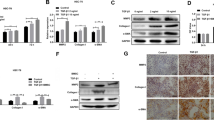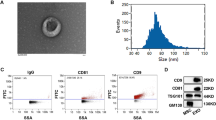Abstract
Objective
To investigate the effects of human bone marrow mesenchymal stem cells (hMSCs)-derived exosome circCDK13 on liver fibrosis and its mechanism.
Methods
Exosomes derived from hMSCs were extracted and identified by flow cytometry and osteogenic and adipogenic induction, and the expressions of marker proteins on the surface of exosomes were detected by western blot. Cell proliferation was measured by CCK8 assay, the expression of active markers of HSCs by immunofluorescence, and the expressions of fibrosis-related factors by western blot. A mouse model of liver fibrosis was established by intraperitoneal injection of thioacetamide (TAA). Fibrosis was detected by HE staining, Masson staining, and Sirius red staining. Western blot was utilized to test the expressions of PI3K/AKT and NF-κB pathway related proteins, dual-luciferase reporter assay and RIP assay to validate the binding between circCDK13 and miR-17-5p as well as between miR-17-5p and KAT2B, and ChIP to validate the effect of KAT2B on H3 acetylation and MFGE8 transcription.
Results
hMSCs-derived exosomes inhibited liver fibrosis mainly through circCDK13. Dual-luciferase reporter assay and RIP assay demonstrated the binding between circCDK13 and miR-17-5p as well as between miR-17-5p and KAT2B. Further experimental results indicated that circCDK13 mediated liver fibrosis by regulating the miR-17-5p/KAT2B axis, and KAT2B promoted MFGE8 transcription by H3 acetylation. Exo-circCDK13 inhibited PI3K/AKT and NF-κB signaling pathways activation through regulating the miR-17-5p/KAT2B axis.
Conclusion
hMSCs-derived exosome circCDK13 inhibited liver fibrosis by regulating the expression of MFGE8 through miR-17-5p/KAT2B axis.
Graphical abstract










Similar content being viewed by others
Data availability
The datasets used or analyzed during the current study are available from the corresponding author on reasonable request.
References
Altamirano-Barrera A, Barranco-Fragoso B, Mendez-Sanchez N. Management strategies for liver fibrosis. Annals of Hepatology. 2017;16(1):48–56.
An SY, Jang YJ, Lim HJ, Han J, Lee J, Lee G, Park JY, et al. Milk fat globule-EGF factor 8, secreted by mesenchymal stem cells, protects against liver fibrosis in mice. Gastroenterology. 2017;152(5):1174–86.
Ankrum J, Karp JM. Mesenchymal stem cell therapy: two steps forward, one step back. Trends in Molecular Medicine. 2010;16(5):203–9.
Desert C, Baeza E, Aite M, Boutin M, Le Cam A, Montfort J, Houee-Bigot M, et al. Multi-tissue transcriptomic study reveals the main role of liver in the chicken adaptive response to a switch in dietary energy source through the transcriptional regulation of lipogenesis. BMC Genomics. 2018;19(1):187.
Dewidar B, Meyer C, Dooley S, Meindl-Beinker AN. TGF-beta in hepatic stellate cell activation and liver fibrogenesis-updated 2019. Cells. 2019;8(11).
Eom YW, Shim KY, Baik SK. Mesenchymal stem cell therapy for liver fibrosis. The Korean Journal of Internal Medicine. 2015;30(5):580–9.
Hernandez-Gea V, Friedman SL. Pathogenesis of liver fibrosis. Annual Review of Pathology. 2011;6:425–56.
Jang YJ, An SY, Kim JH. Identification of MFGE8 in mesenchymal stem cell secretome as an anti-fibrotic factor in liver fibrosis. BMB Reports. 2017;50(2):58–9.
Kim HE, Kim DG, Lee KJ, Son JG, Song MY, Park YM, Kim JJ, et al. Frequent amplification of CENPF, GMNN and CDK13 genes in hepatocellular carcinomas. PLoS One. 2012;7(8):e43223.
Lim JY, Oh MA, Kim WH, Sohn HY, Park SI. AMP-activated protein kinase inhibits TGF-beta-induced fibrogenic responses of hepatic stellate cells by targeting transcriptional coactivator p300. Journal of Cellular Physiology. 2012;227(3):1081–9.
Lin Q, Ling YB, Chen JW, Zhou CR, Chen J, Li X, Huang MS. Circular RNA circCDK13 suppresses cell proliferation, migration and invasion by modulating the JAK/STAT and PI3K/AKT pathways in liver cancer. International Journal of Oncology. 2018;53(1):246–56.
Liu WH, Song FQ, Ren LN, Guo WQ, Wang T, Feng YX, Tang LJ, et al. The multiple functional roles of mesenchymal stem cells in participating in treating liver diseases. Journal of Cellular and Molecular Medicine. 2015;19(3):511–20.
Lou G, Chen Z, Zheng M, Liu Y. Mesenchymal stem cell-derived exosomes as a new therapeutic strategy for liver diseases. Experimental & Molecular Medicine. 2017;49(6):e346.
Luedde T, Schwabe RF. NF-kappaB in the liver—linking injury, fibrosis and hepatocellular carcinoma. Nature Reviews. Gastroenterology & Hepatology. 2011;8(2):108–18.
Matranga C, Tomari Y, Shin C, Bartel DP, Zamore PD. Passenger-strand cleavage facilitates assembly of siRNA into Ago2-containing RNAi enzyme complexes. Cell. 2005;123(4):607–20.
Ogryzko VV, Schiltz RL, Russanova V, Howard BH, Nakatani Y. The transcriptional coactivators p300 and CBP are histone acetyltransferases. Cell. 1996;87(5):953–9.
Ohno S, Ishikawa A, Kuroda M. Roles of exosomes and microvesicles in disease pathogenesis. Advanced Drug Delivery Reviews. 2013;65(3):398–401.
Rand TA, Petersen S, Du F, Wang X. Argonaute2 cleaves the anti-guide strand of siRNA during RISC activation. Cell. 2005;123(4):621–9.
Roehlen N, Crouchet E, Baumert TF. Liver fibrosis: mechanistic concepts and therapeutic perspectives. Cells. 2020;9(4).
Rong X, Liu J, Yao X, Jiang T, Wang Y, Xie F. Human bone marrow mesenchymal stem cells-derived exosomes alleviate liver fibrosis through the Wnt/beta-catenin pathway. Stem Cell Research & Therapy. 2019;10(1):98.
Sasaki R, Kanda T, Yokosuka O, Kato N, Matsuoka S, Moriyama M. Exosomes and hepatocellular carcinoma: from bench to bedside. International Journal of Molecular Sciences. 2019;20(6).
Seki E, Brenner DA. Recent advancement of molecular mechanisms of liver fibrosis. Journal of Hepato-Biliary-Pancreatic Sciences. 2015;22(7):512–8.
Shen J, Huang CK, Yu H, Shen B, Zhang Y, Liang Y, Li Z, et al. The role of exosomes in hepatitis, liver cirrhosis and hepatocellular carcinoma. Journal of Cellular and Molecular Medicine. 2017;21(5):986–92.
Toosi AE. Liver fibrosis: causes and methods of assessment, a review. Romanian Journal of Internal Medicine. 2015;53(4):304–14.
Wang W, Dong R, Guo Y, He J, Shao C, Yi P, Yu F, et al. CircMTO1 inhibits liver fibrosis via regulation of miR-17-5p and Smad7. Journal of Cellular and Molecular Medicine. 2019;23(8):5486–96.
Wang H, Lu Z, Zhao X. Tumorigenesis, diagnosis, and therapeutic potential of exosomes in liver cancer. Journal of Hematology & Oncology. 2019;12(1):133.
Weng MK, Natarajan K, Scholz D, Ivanova VN, Sachinidis A, Hengstler JG, Waldmann T, et al. Lineage-specific regulation of epigenetic modifier genes in human liver and brain. PLoS One. 2014;9(7):e102035.
Willis GR, Fernandez-Gonzalez A, Anastas J, Vitali SH, Liu X, Ericsson M, Kwong A, et al. Mesenchymal stromal cell exosomes ameliorate experimental bronchopulmonary dysplasia and restore lung function through macrophage immunomodulation. American Journal of Respiratory and Critical Care Medicine. 2018;197(1):104–16.
Wu L, Zhang Q, Mo W, Feng J, Li S, Li J, Liu T, et al. Quercetin prevents hepatic fibrosis by inhibiting hepatic stellate cell activation and reducing autophagy via the TGF-beta1/Smads and PI3K/Akt pathways. Scientific Reports. 2017;7(1):9289.
Yang L, Fu WL, Zhu Y, Wang XG. Tbeta4 suppresses lincRNA-p21-mediated hepatic apoptosis and fibrosis by inhibiting PI3K-AKT-NF-kappaB pathway. Gene. 2020;758:144946.
Yu F, Guo Y, Chen B, Dong P, Zheng J. MicroRNA-17-5p activates hepatic stellate cells through targeting of Smad7. Laboratory Investigation. 2015;95(7):781–9.
Yu F, Lu Z, Huang K, Wang X, Xu Z, Chen B, Dong P, et al. MicroRNA-17-5p-activated Wnt/beta-catenin pathway contributes to the progression of liver fibrosis. Oncotarget. 2016;7(1):81–93.
Zhang T, Hu J, Wang X, Zhao X, Li Z, Niu J, Steer CJ, et al. MicroRNA-378 promotes hepatic inflammation and fibrosis via modulation of the NF-kappaB-TNFalpha pathway. Journal of Hepatology. 2019;70(1):87–96.
Funding
Thanks for the grants from National Key R&D Program of China (No. 2019YFE0190800); Key R&D Program of Hunan province (No. 2020SK2083); the National Natural Science Foundation of China (No. 81500455 ); the National Natural Science Foundation of China (No. 81974079); the National Natural Science Foundation of China (No. 82070646) and Hunan Provincial Health Commission (No. 202120700992).
Author information
Authors and Affiliations
Contributions
MJ and JYF conceived the ideas. MJ and JYF designed the experiments. JYF and LY performed the experiments. LY and CMX analyzed the data. CMX, WWH, and ZQQ provided critical materials. HB and ZM wrote the manuscript. MJ supervised the study. All the authors have read and approved the final version for publication.
Corresponding author
Ethics declarations
Conflict of interest
The authors declare no competing interests.
Ethics approval and consent to participate
All experimental procedures involving animal were conducted with the consent of Institutional Animal Care and Use Committee of the Second Xiangya Hospital.
Consent for publication
Not applicable.
Additional information
Publisher’s note
Springer Nature remains neutral with regard to jurisdictional claims in published maps and institutional affiliations.
Highlights
• CircCDK13 inhibits liver fibrosis at the cellular and animal levels.
• CircCDK13 targets and binds miR-17-5p, while miR-17-5p targets KAT2B.
• CircCDK13 regulates liver fibrosis by regulating the miR-17-5p/KAT2B axis.
• CircCDK13 affects MFGE8 by regulating miR-17-5p/KAT2B axis to regulate liver fibrosis.
• CircCDK13 inhibits PI3K/AKT and NF-κB pathways by regulating miR-17-5p/KAT2B axis.
Supplementary Information
Rights and permissions
About this article
Cite this article
Ma, J., Li, Y., Chen, M. et al. hMSCs-derived exosome circCDK13 inhibits liver fibrosis by regulating the expression of MFGE8 through miR-17-5p/KAT2B. Cell Biol Toxicol 39, 1–22 (2023). https://doi.org/10.1007/s10565-022-09714-4
Received:
Accepted:
Published:
Issue Date:
DOI: https://doi.org/10.1007/s10565-022-09714-4





